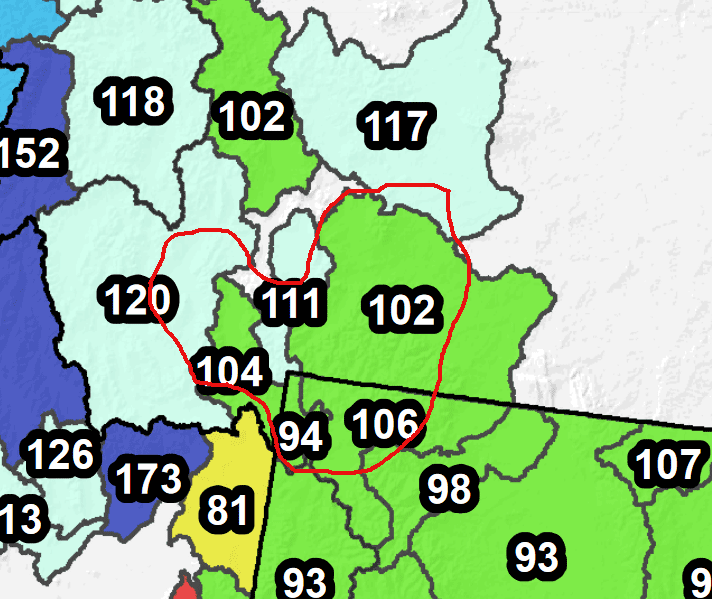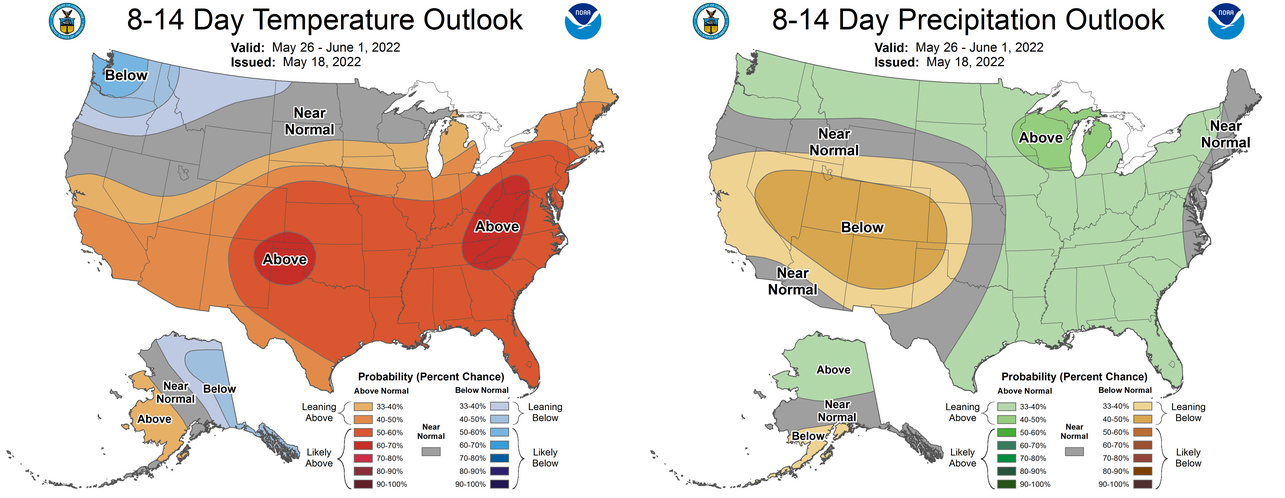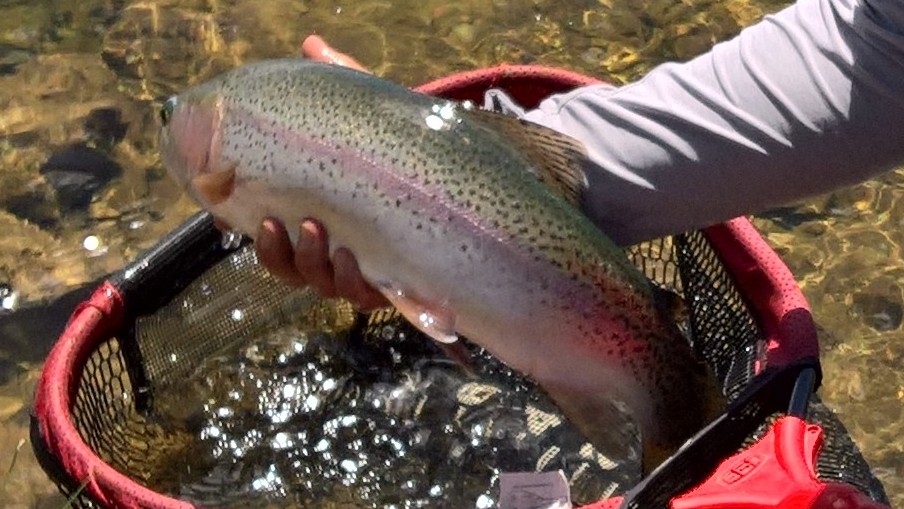Snowpack & Runoff Update and Summer Streamflow and Fishing Forecast
Posted on May 19th, 2022 in Season Forecasts, Weather & Water Conditions
Introduction, Current Conditions, and Long-Range Outlooks
Here in Yellowstone Country, winter snowpack and how this snowpack melts from late April through June play the most important roles in summer water supply for both fish and agriculture from early June through mid-September. June through mid-September temperatures and rainfall play a secondary role. Only after mid-September does day-to-day weather play the largest role in overall water levels and water quality. Winter and spring weather are thus very helpful in planning summer fishing trips to the region.
On the heels of low snowpack in 2020-2021 followed by a record warm, dry summer that came early, we are currently in severe to extreme drought throughout the YCFF operations area. About half our operations area is in each category, which is an improvement from a month ago when 3/4 of our operations were in extreme drought. The core of winter brought no relief from this drought. As of March 31, snowpack sat at just over 70% of normal in most areas and we anticipated exceptionally low snowpack and thus extreme to record low streamflows. Following from this, we anticipated widespread stream closures and bad fishing conditions in late summer.
Thankfully, we enjoyed the coldest April since 1997. May has been more of a mixed bag, with several-day runs in the 70s followed by several-day runs in the 40s or 50s. The next three days are forecast to be cold and wet, with significant mountain snowfall, but then it’ll rise back into the 60s. The spring runoff has begun on all rivers, having started around May 15th-16th, about a week late. Overall, we saw drastic improvements in our water situation through early spring, with snowpack rising sharply and soil moisture at low elevations improving due to substantial rainfall. This has significantly improved our outlooks for the core summer season from our early April outlook, when we basically thought the sky was falling and expected absolutely terrible water conditions this year.

Snowpack as of May 19, with our approximate operations area circled in red.
As of right now, snowpack within our operations area is at 94% to 120% of normal. This is a huge increase from the end of March doldrums, when things were at 68% to 80% of normal. The most important basins–the Yellowstone River Basin in WY and Yellowstone Park and the Yellowstone River Basin in Montana–are at 106% and 102% of average, respectively.
These near-normal and above-normal numbers are rather misleading because they reflect the cold spring we’ve had rather than actual precipitation. Peak snow depths at most snow sensors (click around at this link) were far below normal. This snow just reached peak depth late and hasn’t melted as quickly as usual. Because of the ongoing drought, much of the snowmelt will just go straight into the ground to replenish soil moisture, rather than making it into streams. As such, we still anticipate below-normal streamflows during the core June–September season. They just won’t be as drastically low as we expected six weeks ago.
Current NOAA outlooks through the remainder of May suggest near-normal temperatures and precipitation, which is fine. We would love to have it remain cold and wet, but normal is far better than the hot and dry we had last year, which led to runoff finishing by early June. There is now no chance of that happening this year.

Long-range outlooks (the monthly outlook for June and the seasonal outlook for June–August) do not look so friendly. We are forecast to see above-normal temperatures and below-normal precip. Boo.
Visit NOAA’s Climate Prediction Center for the full range of long-term outlooks as well as lots of information on ENSO, assorted oscillations, and other weather and climate info that goes right over my head.
Summary of Anticipated Water & Fishing Conditions
In a general sense, here’s what we expect for June through mid-September streamflow and fishing conditions. This is based on current conditions and the longer-range outlooks. Think of the following as something like a weather forecast from a week out: it’s too early for specifics, but the general outline is probably accurate.
- The spring runoff began a few days ago, about a week late. While the runoff began with exceptionally sharp rises in flows (the Lamar River jumped from about 600 cubic feet per second flow to about 3600 in three days, the Yellowstone from 2500 to 7000), these were related more to abundant remaining low-elevation snowpack than to extreme heat. Cold to seasonal weather for the next week or two leads us to anticipate a normal progress of the spring melt from here on out.
- After the heavy melt hits and then recedes, the best fishing is likely to occur between about June 25 and early August. Thereafter, cloudy days and rougher water will be best at least until the weather deteriorates in September. We do not anticipate widespread 2:00PM drought/heat closures on our prime waters barring extreme summer heat. This is a profound improvement.
- Below-normal snowpack and resulting summer streamflows are now certain. As long as we do not suffer the month-long heat dome that occurred last year between mid-June and mid-July, flows will be somewhat below normal rather than record low. Many visitors will not notice much difference from previous trips to the region.
- We anticipate a light snowmelt but a near-normal end to the snowmelt cycle, with the melt generally ending between June 20 and July 4 depending on the water in question. This discrepancy reflects the fact we are in drought and have a somewhat low snowpack, but that this snow is melting late.
- July is almost certain to offer the year’s most-consistent water conditions when the area is taken as a whole. Conditions will be good in late June in many areas and into early August on some of the colder, rougher waters.
- The fish are likely to be spooky and difficult from sometime in early August through mid-September in many areas. In August and September, steeper, faster, deeper water will fish much better than the flat, shallow stuff.
- 2:00PM fishing closures will occur in late July and August on a few low-elevation waters, but will be rare if we have normal or even somewhat hot weather in summer. These closures are unlikely to impact the “core” fisheries (YNP, upper Madison, Stillwater River, Yellowstone River above Livingston) that are most popular at this time. That said, late afternoon and early evening fishing is likely to be poor from late July through August. More widespread 2:00 closures are possible if we have extended record heat in June and July as we did in 2021.
- Complete 24hr closures are extremely unlikely even if we have a brutal heatwave like we had in 2021. This is another huge improvement and relief. A month ago we thought there was a 1 in 3 chance of such closures.
- Due to tinderbox conditions throughout most of the West, fires and smoke from both local and distant fires are likely to be very bad this year beginning in late July.
- Due to the winding-down of COVID (we hope) prompting high tourism, as well as the rapidly increasing population in the region, fishing pressure will be intense from the end of runoff through early October, assuming fires and stream closures allow for it. The quality of the fishing will not play any role in how many people are on the water. We are already seeing much more fishing pressure than used to be typical, including record-high bookings for all of spring.
Detailed Fishing Conditions by Water
There have been substantial changes to the following forecasts due to the abundant snow and cold weather we’ve enjoyed in April and early May. In particular, we no longer expect 2:00PM closures in late summer unless we have an extreme heat wave save on rivers that almost always have them, such as the lower Madison River.
Since runoff has now begun in earnest, we are growing much more confident about the accuracy of the following date ranges. If you haven’t booked your lodging or guide service, we suggest doing so ASAP since availability of both is now getting sparse.
Montana Fisheries
- Yellowstone River: Runoff will end between June 20 and the end of June, with June 25 most likely. The Salmonfly hatch will occur for about a week immediately after runoff recedes. It is possible the earliest days of the hatch will see conditions too high and muddy to fish. The fishing will be best on slower, shallower sections of river upstream from Livingston as well as all water east of Livingston prior to early August. Faster, deeper water upstream from Livingston should produce acceptably well all summer unless we see exceptional heat as we did last year, though midafternoon onward will probably be slow in August except on cloudy days. 2:00 fishing closures will depend on weather but are not likely without record heat.
- Madison River: The Lower Madison will not experience any appreciable runoff and will be best prior to June 25. After June 25 it will generally run too warm after noon depending on day-to-day weather. The Upper Madison (really outside my ops area) will likewise probably not experience much of a runoff. It will be best from mid-June through late July. 2:00 closures are certain on the Lower Madison beginning no later than early July. They are very unlikely on the upper Madison.
- Boulder River: Runoff will end late due to intense recent snow. June 20 to July 4 is a reasonable window for the end of the melt, with June 25 most likely. The river will get too low to float by July 25, and perhaps sooner. High water temps and low flows will almost certainly be a problem even for wade-fishing in August due to this small river’s intense irrigation drawdowns. The Boulder seldom sees any fishing restrictions due to water levels or temperature, but in all honesty I expect areas downstream of Natural Bridge should be closed 24 hours a day in August, due as much to irrigation drawdowns as water temps.
- Stillwater River: Runoff will end between June 20 and July 4, with June 25 to July 1 most likely. Upper sections will be too low to float around July 20-25. Lower portions downstream of the Rosebud confluence will remain high enough to float until roughly September 1. Late summer rains will be required for float-fishing to remain an option after that. The best fishing will occur in July and early August, but should be decent so long as flows remain high enough to allow floating. This river will offer our best “action/numbers/dry flies” fishing this year.
- Missouri River: No appreciable runoff will occur. The carp/walleye/pike water upstream from Canyon Ferry Reservoir will as always fish best from late July through early September. The trout water downstream of Canyon Ferry (including “Land of Giants”) will fish best from now through June. Both the trout water and the “other” water are less likely to have closures than any other water we fish.
- Private Lakes: Day-to-day weather is more important on the lakes than snowmelt. These lakes have warmed up very late. Frequently we see excellent hatches in mid–late May. We are still in “leech and streamer mode” due to the cold spring. This late start should keep fishing good well into June, possibly into July in the case of Burns Lake. Hot/bright weather thereafter the determining factor on when things get slow.
- Paradise Valley Spring Creeks: Fishing is always best on the creeks from early March through April, then again from about June 20 through July 20. Unfortunately, radically-increasing pressure on the creeks now means that many prime dates in June-July 2023 are now booked solid. We’re basically done guiding on these creeks except in March-April because of this.
- Other Waters: The Gallatin River will likely drop out of runoff around June 20-25 and possibly get too warm downstream of Gallatin Gateway by late July. The Jefferson River will drop from runoff by June 20 and probably be too warm the instant it does. We will not be offering floats on this river anymore, odds are. The fish populations are too low and too stressed by heat in the lower stretches of river close enough to Livingston. Mountain small streams in Montana will generally fish best from July 10 or so through about August 20, but may hang on into early September if summer is not too hot and dry. Public lakes in Montana will be best in May and June except for carp, which rise to hoppers on some lakes in late July and August.
Yellowstone Park Fisheries
- Yellowstone River: The Lake-Falls stretch opens July 1! This is a change from longstanding tradition. For decades this water opened July 15. We wish the early July closure remained in place to let the lake-run cutthroat finish the spawn in peace. That said, early July will almost certainly offer the best fishing here since the mid-1990s, since cutthroat numbers are increasing in general and almost none of them will have migrated back to the lake on the opener, in contrast to the previous opener which saw many fish already moving back to their winter haunts in Yellowstoen Lake. The fishing will remain good through July. The Grand Canyon from the Falls to the Lamar confluence will become fishable around June 10, though there’s a slim possibility it will be marginally fishable opening weekend if the weather is cold. Most of June will see high and murky but fishable water. The most consistent fishing (particularly if you prefer dry flies) will occur in July and early August, though the fishing should remain good until mid-October. The Black Canyon stretch from the Lamar to Gardiner will track similarly to the stretch downstream of Gardiner noted in the previous section.
- Gardner River: The lower Gardner downstream of Boiling River will be fishable on a day-to-day basis from the opening of the park season, joined by the stretch from Sheepeater Canyon to Boiling River around June 15. Consistent fishing will begin by June 20 and continue in both stretches through about July 20 and above Boiling River until early October. Below Boiling River will be too warm and weedy at the end of July and on through mid-September. The headwaters above Osprey Falls will come in around July 1 and remain good until at least early August.
- Lamar River & Tributaries: Runoff will end sometime in the first week of July depending on the water involved and the weather. The best fishing will occur in July and early August. The water will be low and slow and the fish heavily-pressured and spooky thereafter.
- Firehole River: The Firehole will not experience an appreciable runoff and will fish best between the park opener and June 15. The first hot/dry spell after June 15 will shut down fishing until after Labor Day. While conditions have improved in the Firehole drainage over the past few weeks, they’re still not ideal. In fact, snowpack is lower in this basin than anywhere else in the area. We did not guide on the Firehole in 2021 and almost certainly will not in 2022, either. If current climate models continue, the Firehole will cease to be a relevant fishery downstream of Old Faithful by 2030 due to repeated fish kills associated with high water temperatures.
- Gibbon River: The Gibbon upstream of Norris Geyser Basin will be fishable sometime between June 5 and June 10 and will be best before late July. Areas downstream of Norris Geyser Basin are unlikely to experience an appreciable runoff and will be best between the season opener and June 20. After June 20, the first hot spell will shut the fishing off until September 1.
- Upper Madison River: Generally similar to the Firehole but will hang on for a few days after the first hot spell.
- Lakes in YNP: Ice-out will depend on day-to-day weather but should occur before or right around Opening Day. Travel to the lakes before mid-June might be a wet, sloppy mess due to mud and snowmelt, though all except high-elevation lakes and those in snowy areas (Lewis Lake, I’m looking at you) should be snow-free by the opener. All will fish best from ice-out (or Opening Day, whichever comes second) through June, then trail off through early July.
- Creeks in YNP: Meadow-type streams will become fishable between June 10 and the end of June, with those draining lakes becoming fishable towards the earlier end and those draining mountains falling into shape later. All will be best for the first month after they come in. Rough, mountain creeks will come into shape around the beginning of July and be best for a month to six weeks starting about a week after they fall into shape.
Guide Service Availability
As of this writing, I still have lots of availability in June, August, and September. July is much tighter. I still have a few open days at the beginning of the month for Salmonfly floats or hike & wade trips and late in the month. I am fully-booked from July 5–22 and July 27–30. Contractor guide availability for the days I’m fully booked will also be rather thin during this period.
The following photo is from a private lake trip to Sitz Ranch on May 17. Fishing was so-so, but all fish were 16–21 inches. Photo courtesy Steve Smith. These guys will start eating dry flies in a few days.
